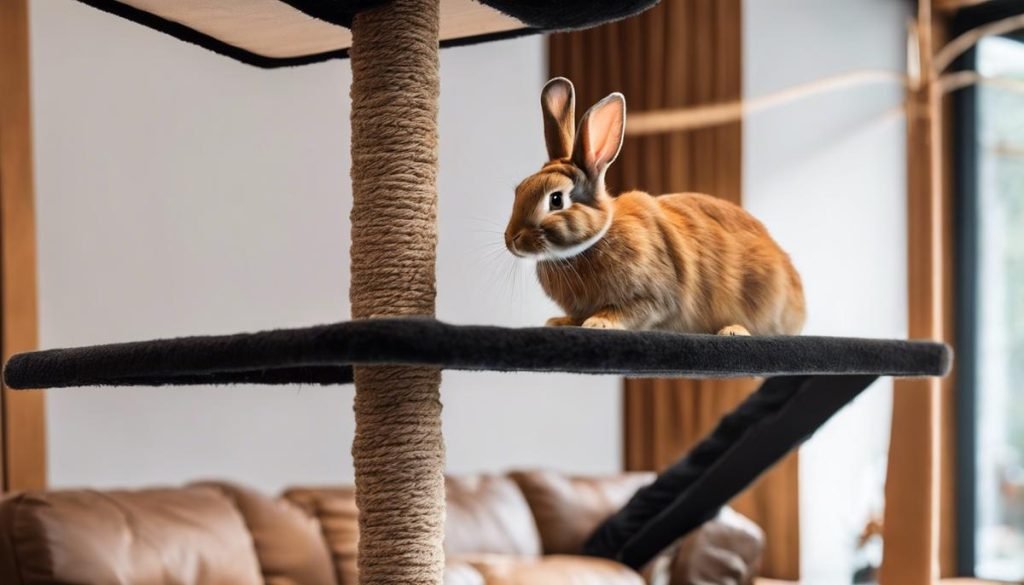When picturing a rabbit at play, one might imagine them hopping around a spacious hutch or softly bounding across a grassy yard. Rarely do we envision these furry friends scaling heights, perched upon platforms designed for their feline counterparts. Yet, the idea of a rabbit using a cat tree sparks curiosity about the adaptability of these creatures beyond their ground-bound escapades. This exploration delves into the world of rabbits and their lesser-known ability to climb, assessing their physical prowess and the suitability of cat trees to cater to their playful spirits. Our journey begins with evaluating the natural climbing abilities of rabbits, setting the stage for understanding how these structures can become a part of their environment – all while keeping their well-being at the forefront.
Understanding Rabbit’s Climbing Abilities
Hop to It: Are Our Furry Friends the Climbers We Think They Could Be?
When it comes to our fluffy, long-eared companions, there’s always more to learn about their delightful and sometimes surprising behaviors. Much like the ever-curious cat with a penchant for high places, you might wonder if your pet rabbit has a similar inclination. Are those cute cottontails secret mountaineers, or are they more grounded than their feline friends?
Time to unravel this bunny mystery!
First, let’s nibble on a bit of rabbit reality. While not quite the Olympic athletes of the animal kingdom, rabbits do have some climbing abilities. Their strong hind legs provide an impressive jump, and believe it or not, they can maneuver themselves onto objects and platforms of various heights. Nevertheless, don’t expect to find these furry friends making a regular habbit — sorry, habit — of scaling your bookshelves.
Rabbits are naturally burrowers, you see. In the wild, their energy is focused on digging extensive networks of tunnels, not climbing to the tree tops. So while they may hop onto your couch or scamper up a small stack of pillows, their affinity for climbing is modest at best.
Now, if you’re witnessing your very own bunny scaling the living room furniture, it’s essential to bunny-proof any potential climbing spots. Since rabbits aren’t built for heights, they’re more prone to injuries if a risky leap doesn’t go as planned. Secure any loose objects that might tempt a wayward hop, and consider investing in some rabbit-friendly platforms or steps to satisfy their mild climbing curiosity.
By providing a safe and enriching environment, including designated climbing fixtures, you’ll keep your bouncy pal both entertained and out of harm’s way. And on a side note, always ensure they have plenty of supervised exercise time to prevent any mischievous mountaineering!
To sum up, while rabbits can climb to a degree, they’re certainly no match for the agile antics of a cat. They’re much happier — and safer — with all four paws on the ground or within a cozy burrow. So continue to delight in your rabbit’s endearing earthbound escapades, and remember, a little hop goes a long way!

Safety Considerations for Rabbits on Cat Trees
Raising rabbits can be a joy, and watching them hop around fills the home with a unique brand of happiness. With so many feline friends enjoying the vertical delights of a cat tree, it’s natural for bunny parents to wonder if a similar setup could enrich their hopper’s life. But before you introduce your rabbit to a cat tree, safety must be your top priority.
First off, let’s talk about stability. Cat trees are designed with nimble felines in mind, not necessarily our furry rabbit friends. Make sure the cat tree is sturdy and won’t tip over if your rabbit decides to try a leap. Anchor it to the wall if possible, just like you would a bookshelf in a toddler’s playroom.
Next up, let’s chat about accessibility. Ramps or small steps can create an easier and safer climb for a bunny. Their little legs are great for hopping, but steep or narrow ledges are an accident waiting to happen. Opt for wide platforms and gradual inclines that will keep Mr. Whiskers steady on his fluffy feet.
Now, consider surface traction. Rabbits don’t have the retractable claws cats do for gripping. So, it’s essential to apply non-slip materials like carpet or grip tape to the surfaces of the cat tree. Falling from even a small height can lead to serious injury for a rabbit, so make those climbing surfaces as slip-proof as possible.
Height restrictions are a must. While curiosity might get the better of them, rabbits aren’t built for high-rise living. Keep the cat tree modified so it’s more of a bunny hill than a mountain – the lower levels are just fine.
Inspect all areas for any protruding nails or staples that may harm your rabbit. Along with a quick fix with a hammer or staple gun, regular inspections will ensure there are no sharp surprises.
Last but not least, always monitor playtime. Just as we keep an eye on the kiddos at the playground, stay close when your rabbit is exploring new heights. It’s a whole new world up there, and they could use a little support and guidance as they climb.
By taking these safety precautions, you and your floppy-eared friend can safely explore the fun that a modified cat tree has to offer. While it might not be their natural habitat, with the right adjustments, it can provide a stimulating and safe environment for your adventurous bunny.

Appropriate Cat Tree Selection for Rabbits
Choosing the Perfect Cat Tree for Your Hoppy Friend
As devoted parents to our furry family members, we understand that our whiskered companions each come with their unique blend of needs and quirks. And when it comes to our hoppy friends, providing the appropriate environment is key to their wellbeing. While rabbit owners know that these adorable creatures are far from the tree-scaling acrobats their feline counterparts can be, there’s still room for vertical exploration that accommodates a rabbit’s distinctive playful nature.
When seeking a cat tree that doubles as a rabbit play area, it’s essential to prioritize the stability of the structure. Our bounding bunnies may not scale heights like cats, but they do appreciate a good hop and need a sturdy platform that won’t tip over. Look for cat trees with a broad base that will stay put during those energetic moments.
As bunnies aren’t natural climbers, accessibility is another significant consideration when transforming a cat tree into a rabbit-approved playhouse. Gradual inclines are much friendlier to rabbit agility, so choose designs with low, wide steps or ramps that can aid their little legs in reaching each level without strain.
Furthermore, remember that our rabbits’ paws are different from the padded paws of cats. Their grips aren’t quite meant for slick surfaces. To assist them in navigating their new playground safely, make sure each platform offers ample traction. Adding non-slip mats or carpeting can give them the extra footing they need to avoid any slides or stumbles.
While bunnies might show a curiosity for climbing, remember that they don’t have the same grace when it comes to higher elevations. To prevent any daredevil antics that might lead to injury, keep the height of the cat tree moderate. A great rule of thumb is to ensure that the height is something a rabbit could safely jump down from, as soaring structures are simply out of the question for our furry ground-dwellers.
Before introducing your rabbit to their new activity center, conduct a thorough inspection. Any sharp edges, protruding nails, or staples could cause harm, so it’s our job to make their play area as safe as the rest of their lovingly maintained habitat.
Even with the most rabbit-friendly cat tree, it’s important to watch over our pets as they explore their new environment. Monitoring playtime ensures prompt action if there is a slip or if the rabbit seems unsure. This allows you to make any necessary adjustments to their play area, ensuring they have the fun they deserve without the risk.
In conclusion, while it may take a bit of searching to find the perfect climbing frame for a rabbit, the effort pays off in the joy and stimulation it can provide. With the right structure, careful preparation, and attentive supervision, a cat tree can be a wonderful addition to your bunny’s playful repertoire – a furniture piece that respects their earthy roots while giving them a safe taste of the high life. Ready, set, hop to it!

The leap of introducing a rabbit to a cat tree can indeed be a harmonious blend of interspecies furnishing, when approached with diligence and a consciousness of their unique needs. By ensuring that the structure is robust and rabbit-friendly, pet owners can provide a stimulating and enjoyable experience for their hoppy companions. As rabbits make their climb, they not only fortify their physical health but also enrich their mental landscape, proving that with the right support, even the most grounded creatures can rise to unexpected occasions. Watching them navigate their new aerial playground will affirm the delight in offering our animal friends innovative ways to thrive.



